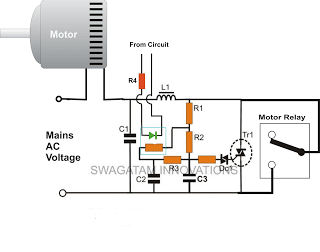In this post I have explained a few innovating and simple soft start circuit examples which may be implemented with heavy duty motors so that they are able to initiate with a soft start or a slow sluggish start instead of a sudden, bumpy start
Why Soft Start is Crucial for Heavy Motors
When heavy motor systems or high current motors are involved, initial switch ON current surge often becomes an issue. This surge tends to inflict huge arcing across the pump relay contacts causing corrosion and reduction in its life due to stress, and wear and tear.
The high current arcing not only causes relay contact issues, but also affects surrounding electronic circuits, causing them to hang or get disturbed due to large amount of RF interference generated during motor switch ON.
However safeguarding the costly motor relay becomes the main issue with such situations. Though there are many mechanical contactors available for controlling motor stress, these system are not efficient and are ineffective against the RF emissions.
The simple electronic circuit presented below hopefully is able to eliminate all issues concerned with heavy motor switch ON surge generation and relay contact protection.
The figure shows a simple dimmer switch circuit incorporating an ordinary triac and diac configuration, which can be very effectively used for adding a soft start to any high current, heavy AC motor.
Designing a Soft Start using Triac Phase Chopping
Here the control pot has been replaced with a LED/LDR box. As we know that in normal dimmer switches, a variable resistance is used for controlling the fan speeds. Here the variable resistance is replaced with a LED/LDR arrangement. It means now the speed of the motor, or in other words, current to the motor can be controlled by controlling the intensity of the enclosed LED through an external trigger.
That's exactly what is done here. When the motor relay is switched ON, either by a switch or through an electronic control circuit such as a water level controller circuit, the LED of the attached dimmer switch is also switched ON simultaneously.
The LED switches ON the triac and the connected motor.
Being a solid state device the dimmer switch acts a little faster than the relay and therefore the motor is first activated through the dimmer triac and just after a few milliseconds the triac gets bypassed by the concerned relay contacts.
The above process completely eliminates any sparking from the relay contact since the triac has already absorbed much of the current and the relay only has to softly takeover the already switched ON motor conduction.
Here the brightness of the opto-coupler LED is crucial, and must be set such that the triac is only 75% ON.
This adjustment will save the triac from initial heavy current transient and help the entire system to last for many many years.
The resistor R4 may be appropriately set for achieving an optimal glow over the LED.
Circuit Diagram
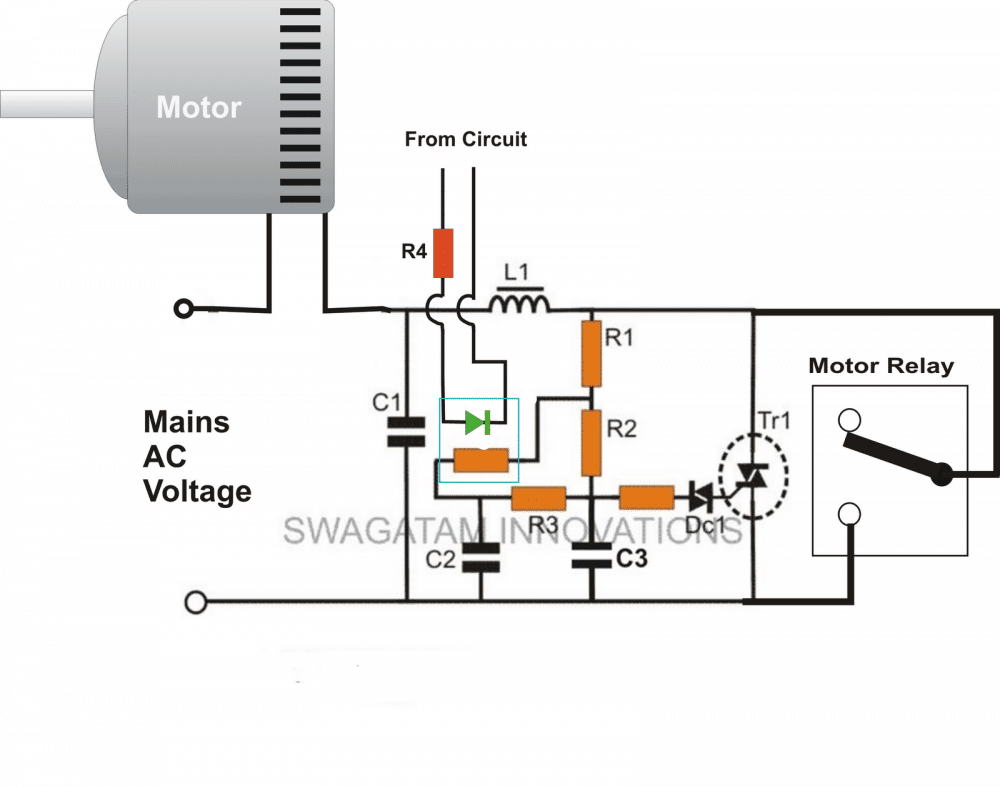
Parts List
R1 = 15K
R2 = 330K,
R3 = 10K,
Diac resistor = 100 Ohms,
R4 = to be adjusted as explained,
C1 = 0.1uF/400V
C2, C3 = 0.1uF/250V,
L1 = 10 amp/220V choke
Triac (Alternistor) = 10 Amp 400V,
Diac = as per the above triac.
Upgrading Triac Soft Start with Relay
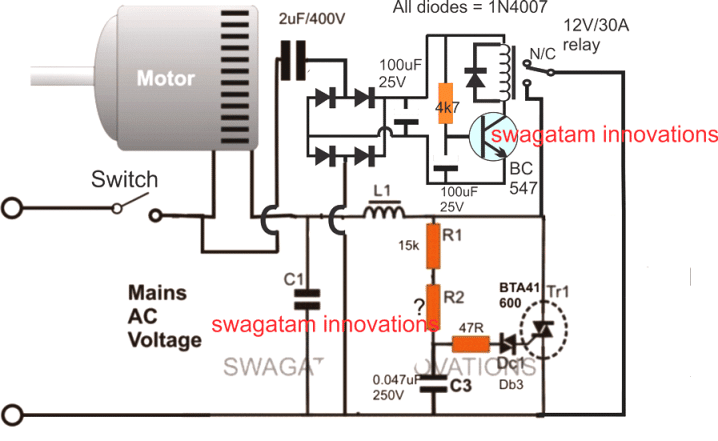
A little inspection reveals that the circuit actually does not require the opto coupler circuit at all. The circuit may be simply arranged in the following manner:
R2 should be selected such that the triac conducts only 75% of the power.
When power is switched ON, the triac provides a soft initial start to the motor until within the next split second when the relay also conducts enabling the motor the required full power. This completely safeguards the actuator contacts from the initial current surges and sparks,
Simplified Soft Start Design
As rightly suggested by Mr.Jim, an initial torque is imperative for initiating a motor optimally especially when it's loaded, if this initial torque is absent. the motor might stall with heavy loads under its belt and might start smoking within minutes.
The following circuit is designed for solving both the issues together, it inhibits the initial surge current to the ON/OFF switch and yet allows the motor to start with a "kick" so that it initiates without problems even when it's loaded.
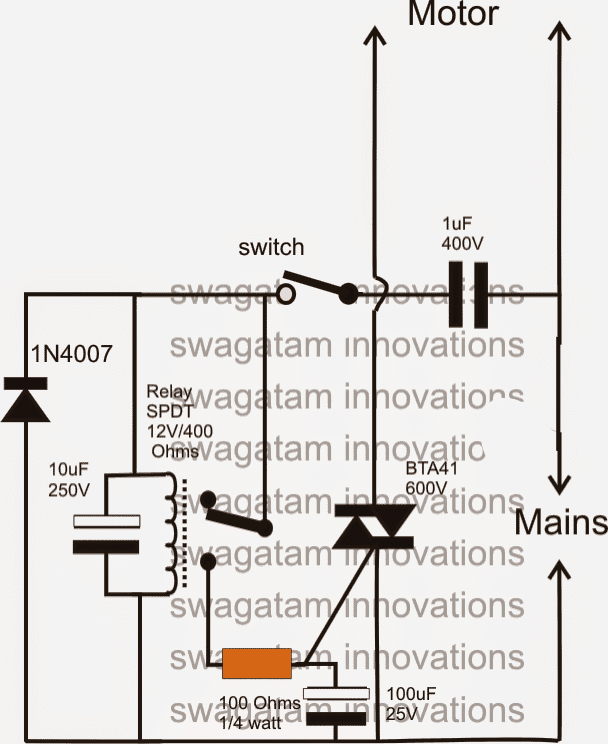
The above design can be even further simplified by removing the relay, as shown below:
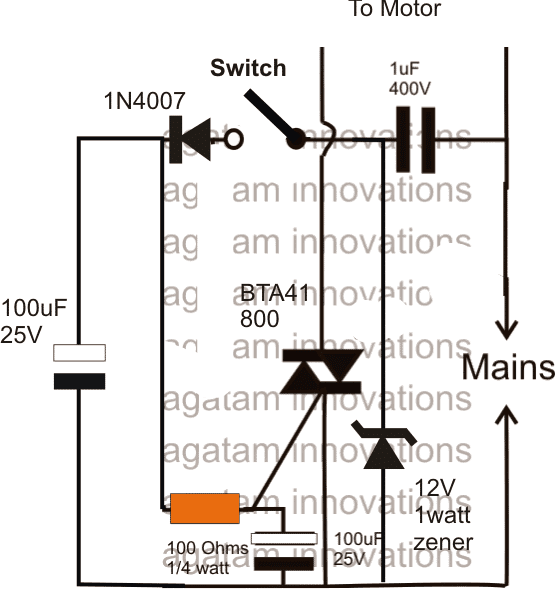
An technicallu more sound PWM based motor soft start circuit can also be tried for getting a better control, a better torque and a reliable startup for the connected motor, even for 3 phase motors.
Soft Start Using Controlled Phase Chopping
Another way of implementing triacs through stepped phase chopping, for initiating slow soft start and slow end or slow stop circuit for heavy machine motors so that the motors are able to go through a gradually start stop actions instead of switching ON/OFF abruptly.
The idea is basically intended to ensure less wear and tear on the motor and additionally save electricity during the course of actions.
The idea was requested by Mr. Bernard Botte.
Dear mister Swagatam,
Sorry for my English , thanks anyway for any answer you will give Before the question. I use different apparatus to handle wood using universal AC motor originally made for a range between 230 to 240 volt 50hz (but I notice in certain part of my country 250V too) because I need a lot off different kind of machine and that was only for hobby.
I buy the cheapest machines I can find (I correct certain mechanical problems) for other machines. I use also a dimmer (home made based on the system used by vacuum cleaner and modified byNINA67 ) and It work great.
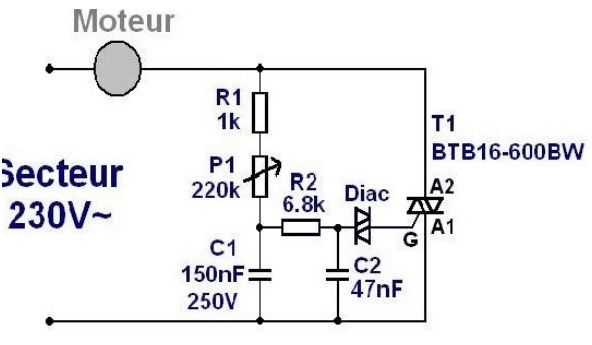
The motor run at +/- 18000 : 3 =6000 !!! Knowing the cheap cost of that machine I use it like a “good father” not intensively etcBut one day there was a fume
The machine smoke and i dismount the machine to isolate the motor to evict the fire . (the machine was under warranty but i need to make a lot off kilometers to make an exchange. And there, they don’t tell me it was a well known and reccurent problem … but … they know it! )
In fact when everything was cold . I look the axis who rotate he seems also shooting on the opposite side of the gear belt at every start Like there wasn’t a grower.
I show the motor in a company saling different kind of motor.
They make also refurbishing but they explain to me that it was an “exotic” motor but they set the same diagnostic .Start to fast So come my question: Could you please make a schematic to have a “soft start / soft ending ” for different universalmotors in fact if i use my dimmer system based on BTA 16 800 cw (better than the other mentioned above) it seems ok but i have only made 3 of them . I’ll want to integrate that in every big machine .
And use only the on/off switch.I want use thus a button to “switch on” and one to “switch off” or an on/off switch.
But also a potentiometer to select the minimum level (depending the power of each motors) when the motor start running and a potentiometer to select the timing (555) between the slow start and the full speed (maybe also shortcut the triac with a relay to have full speed an a green led if it is relevant (but it will be nice) for the switch off the timing maybe reduce. Why at the end because the extra current and problems binded.
Note : I have seen this application with “fpla” or dedicated processors but I am sure it can also be done with discrete components.Why i can not do that : because I never study the motors correctly but I know for example that it is not correct to start the motor with a zero crossing system because It give a maximum current and that make the same trouble (FIRE!) with the couple at start and max current …
I have seen this request in other forum touching other job mechanic wood etc … with no answer and people say also if it work with a potentiometer but when you change from a machine to another you can make mistakes etc…Regards Botte Bernard (Belgium)please don’t put my adress on the net Nb i like also in your presentation the datasheet because it’s no so easy to have it without paying
Bernard Botte
Designing the Stepped Phase Control Circuit
The requested idea of a soft start, soft stop motor switching circuit can be implemented using a simple triac based dimmer switch concept, as presented in the following diagrams:
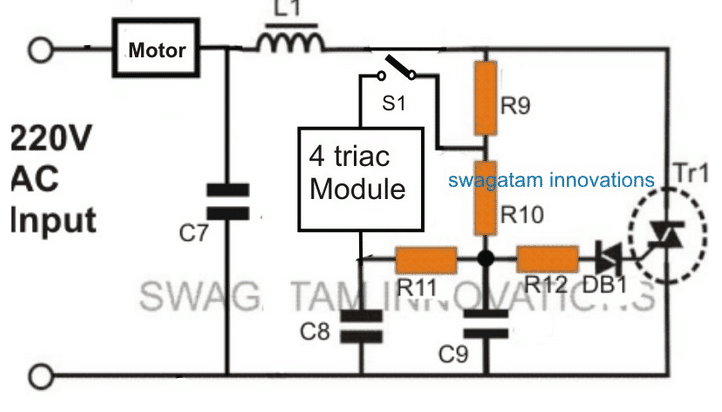
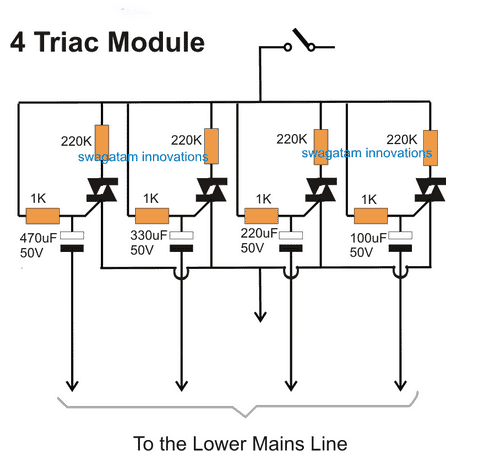
Referring to the above diagrams, the first diagram shows a standard light dimmer or a fan dimmer switch circuit using a heavy duty triac BTA41A/600.
The section which indicates the “4 triac module” is normally occupied with a potentiometer for enabling a manual speed control adjustment, wherein a lower resistance adjustment generates higher speed on the fan motor and vice versa. In this soft start, soft stop design, this pot section is replaced with the indicated 4 triac module which can be elaborately visualized in the second diagram.
Here we see 4 triacs arranged in parallel having 4 individual 220K resistors at their upper MT1 arm, and 4 individual capacitors at their gates with different values, and with a sort of sequential order of high to low. When S1 is switched ON, the triac having the lowest value capacitor switches ON first, enabling a relatively slow speed start on the motor due to switching of the relevant 220K resistor at its MT1.
Within a few millseconds the next subsequent triac conducts which has the next smaller value, and adds its own 220K resistor in parallel with the earlier 220K resistor, allowing the motor to gain some more speed. Identically, the third and the fourth triacs also sequentially switch ON within the next few milliseconds, thereby adding two more 220K parallel resistors in the range, which finally allows the motor to reach its maximum speed.
The above sequential speed increase on the motor allows the motor to achieve the intended slow start switch ON, as desired by the user.
Quite similarly when the switch S1 is turned OFF, the relevant capacitors switch OFF in the same order but in a descending manner, which inhibits the motor from a sudden stop, instead it causes a step wise slow stop or slow end on its speed.
Feedback from Mr. Bernard:
Dear mister Swag, First of all, thanks for your fast answer. Because you tell me you have a timing problem I have changed my operating system to linux mint 18,1 ‘Serena’ so i haved to re-install all the program I need and test it (setup it!) So apparently everithings seems working OK ! About the first schematic I notice you don’t give any value to the upper side schematics so I pick it up from « How to Make a Simplest Triac Dimmer Switch Circuit »
Parts List for the above enhanced fan dimmer circuit(C1) C7 = 0.1u/400V
(C2, C3) C8,C9 = 0.022/250V,
(R1) R9 = 15K,
(R2) R10 = 330K,
(R3) R11 = 33K,
(R4) R12 = 100 Ohms,VR1 = 220K, or 470K linear => Replaced by genial 4 triacs module
Diac = DB3,
Triac = BT136 => BTA41 600
L1 = 40uH
About the second schematic so simple solution i never have dreamed !!! to be tested asap Genial! we say in French.
I doesn’t know that you can use polarized condensators for such AC applications! And also that 50 volt was sufficient! I you have a moment to explain why -
Anyway maybe i’ll try it this weekend if i have all the component. I prefer use new capacitors my stock never change since 1993!
In fact i was trying different ways using for example opto triac (MOC) but i also need to pick the freq of the AC network, also another based on your schematic Kiln Temperature Controller Circuit but with up down counter 4516b and 555 etc,etc so complicated
Many thanks
Regards
B.botte
My Response:
Thanks dear Bernard,
The image which you had inserted in the conversation did not get attached properly and therefore it was not showing, but I have corrected it now and have posted it back in the article.
I have rated the caps at 50V because R9 is supposed to be a 33K or a 68K resistor which will drop the current significantly and not allow the capacitors to burn, this is my understanding.
I have used polarized capacitors because the gate of a triac works with a DC drive, but yes you are right, in order to make it DC for the capacitors we need to add a 1N4007 in series with the gate 1K resistors.
Now with regards to this design, if suppose the idea does not operate very smoothly or fails to produce the expected results, we could modify the existing gate drive for the 4 triacs into optocoupler based drivers, and perform the same sequential delayed switching but through an external DC circuit.So this circuit ultimately has the potentials to deliver the intended results, either this way or that way.Regards Swag
